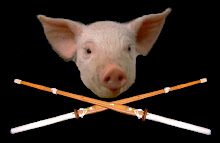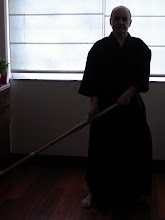Do you have your own dojo in Japan?
Well, you wouldn't really call it a dojo because it is attached to my home. It is rather small. It has been there for the past 40 years.
Otsuka sensei died 20 years ago so this is the 20th anniversary of this death. When he was about 75 years old, (he died when he was 90) I was the shihan (chief instructor) at Komazawa university in Ishikawa prefecture. He came to Ishikawa prefecture to instruct my students and also to give me personal instruction. It was an experience I will cherish forever and this happened on several occasions.
The skills that I have today are a result of the mental image I retained from that period of time when I trained under his personal supervision. I kept that image of him in my mind so even though he passed away, I retained that picture in my head . I used that image as a model and used it as a basis for my training and that was the way I developed my techniques.
Skill is not something that you acquire overnight. It takes years to develop. So when I trained with him I was not trying to acquire technique, instead I was trying to imprint the image of his movements in my head. So after he left, I did my best to recollect my memory and used this for my day to day training.
Did you ever consider to live abroad to spread Wado?
In Showa 39 (1964), Tatsuo Suzuki, Toru Arakawa, a member of the central examination committee for JKF Wadokai, and myself traveled across Europe. And then after that Suzuki was the first person to teach Wado karate in Europe. I was one year behind Suzuki in college.
What was your relationship with Otsuka Sensei?
Otsuka Sensei was the shihan of my karate club at Nihon University. And after I graduated, I received private instruction as an alumnus of the university.
My personal relationship with Otsuka Sensei deepened when he started to visit me when I was teaching at the university. He would come to teach and also give me private instruction.
What is the importance of Wado?
In Budo there is Judo, kendo and karate. But our karate is unique because it is a combination of Okinawan karate and the jujitsu that Otsuka Sensei learned. So it is very different from Shotokan, Goju, or Shitoryu. It has its own unique beauty.
Does karate improve character?
The people that become good in karate are not necessarily the ones who are physically coordinated or gifted. The people that become good are the ones who can stick with one thing over a long period of time.
And do their personalities change over time?
No, probably not. Obviously the person who decides to pursue budo or karate already has a different mindset than the average population and they have the ability to narrowly focus on studying techniques. So they bring this characteristic with them when they first start martial arts.
Otsuka Sensei tried to spread the whole circle to the world but the instructors who have gone out to teach only know bits of this circle and not the entire content.
What do you think of Wado, as practiced nowadays?
Otsuka took many years to created this form of karate. He kept developing it until he was 90 years old, 60 years worth of work. How can we learn it all in 10 or 20 years? None of us can reach his level of expertise, but we try to come as close as we possibly can, given the limits of our ability and there lies our challenge. Instead of doing exactly the same thing as him, we must try to do our best in our training by trying to understand what he was thinking and try to come as close to that as humanly possible.
In the olden days, whether it be kicking or punching, we just did it rather wildly. Today we are much more sophisticated and we try to eliminate all excess movement, excess power and we use sabaki to evade the power of the opponent.
The Wado karate of today is not a karate of strength, like breaking stuff, but is more of a karate of speed. This is a result of the influence of competition karate. Competition karate relies on speed.
Visualize a circle. Imagine that everything Otsuka Sensei taught can be enclosed in this circle. Many of his students have taken only various bits of this circle. Otsuka Sensei tried to spread the whole circle to the world but the instructors who have gone out to teach only know bits of this circle and not the entire content. So unless the instructors are mindful of this, Wado will not develop in the right direction.....
What is your opinion on the division of Wado in three factions?
The goals of the organizations are all the same. They all believe in karate, they all teach karate. The differences only become apparent through the personality of the instructor. We say shuhari, right?: First we learn, then we we train, then we evolve. So the top instructors like Tatsuo Suzuki have already gone to the Ri phase of their training and that is why I believe they are different.
But even though we may be slightly different, it is fundamentally WRONG tocreate a new organization. Wado could potentially be a lot stronger if it remained united. The ideas of Otsuka sensei could have a strong impact in the world, but if you make a mistake it can derail the whole process - at least this is my opinion......
Hajime Takashima is on the technical committee of both JKF and the JKF-Wadokai. He is also a member of the JKF Referee Council.This interview was conducted with the kind help of Ichikawa-sensei, who helped to translate the questions to Japanese.
An interview by Igor Asselbergs/Bob Nash may 16, 2002 (http://www.wadoworld.com/articles/takashima/takashima.html)
Maquetas ultimos trabajos
Hace 2 años





No hay comentarios:
Publicar un comentario